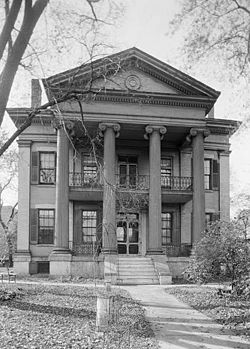- Chatillon-DeMenil House
-
Chatillon-DeMenil HouseSt. Louis Landmark
 Chatillon-DeMenil House in 1936
Chatillon-DeMenil House in 1936Location: 3325 DeMenil Place (13th Street)
St. Louis, MissouriCoordinates: 38°35′35.91″N 90°12′59.24″W / 38.5933083°N 90.2164556°WCoordinates: 38°35′35.91″N 90°12′59.24″W / 38.5933083°N 90.2164556°W Built: 1848-1863 Architect: Henry Pitcher Architectural style: Greek Revival Governing body: Chatillon-DeMenil House Foundation NRHP Reference#: 78001673 Added to NRHP: June 9, 1978 The Chatillon-DeMenil House, located at 3325 DeMenil Place in Soulard, St. Louis, Missouri, was begun in 1848 for the pioneer Henry Chatillon, then enlarged to its present form by prominent St. Louis businessman Nicolas DeMenil from 1855 to 1863.[1] The house serves as a house museum, and according to its nomination to the National Register of Historic Places, "some see the DeMenil House as being the finest example of Greek Revival architecture in the Midwest."[1]
Contents
Original home
The property where the house was built was part of a five acre tract purchased by Odile Delor Lux, a granddaughter of Clement Delor de Treget, the founder of Carondelet, Missouri. The property originally was part of the St. Louis common fields. In 1848, Lux married Henry Chatillon, who had become somewhat famous as the leader of the expedition of Francis Parkman in The Oregon Trail.[2] By 1849, a house stood on the property owned by Lux. This house was either moved to the location from Carondelet or built there after the marriage.[1] The early house was a simple, two-story brick farmhouse with four rooms and a one-slope roof.[1][2]
Regardless of Chatillon's renown, parcels of the tract were sold in 1850, and the remainder of the property (including the farmhouse) was sold in 1855. The purchaser was Nicolas DeMenil, a French physician who married Emilie Sophie Chouteau in October 1836.[1][3] DeMenil and his wife initially purchased the house as a summer retreat from the city center, but by the beginning of the Civil War they decided to reside in it year-round. Their decision to move partly was based on their sympathy with the Confederacy combined with the garrison of Union soldiers in St. Louis.[1] Upon moving to the house, the DeMenils hired Henry Pitcher, a carpenter and contractor, to remodel and expand it.[1]
Renovations and expansion
The house's western side was expanded 12 feet (3.7 m). This addition consisted of three stories, two porches, and possibly the carriage house. Renovations were complete by 1863. However, due to development in the surrounding area (partly financed by DeMenil himself), the view of the river was obstructed from the house, and the front entrance was moved to face 13th Street and balustrades and a porch were added to improve the appearance of the new entrance in 1879. Nicolas DeMenil died shortly after completing the new entrance; his son, Alexander DeMenil, inherited the home and lived in it until his death in 1928. A third generation of DeMenils moved into the home only to find the area had deteriorated, and moved in 1940.[1]
Paleontology, decline and renovation
In 1940, local pharmaceutical manufacturer Lee Hess converted the home into apartments, reserving one for himself and his wife.[1] His discovery of an extensive cave on the property led him to find remains of the peccary of the genus Platygonus. The noted paleontologist George Gaylord Simpson proceeded to move into the home, using it as a staging area for investigating the remains of prehistoric animals in the caves.[1]
By the 1950s, the home was becoming derelict, and plans for Interstate 55 called for the demolition of the home. However, a route change in 1961 permitted the home to be saved by the Landmarks Association of St. Louis.[2] The Union Electric Company contributed to the purchase of the home and sponsored its renovation in concert with the Landmarks Association, and the Missouri Department of Transportation agreed to the plan.[1] In summer 1964, renovations began under the authority of architect Gerhardt Kramer, and the home was dedicated the next year. The Landmarks Association created the Chatillon-DeMenil House Foundation as owner of the house, and it continues to operate the home as a museum.[1][2]
References
- ^ a b c d e f g h i j k l Neilson-Kurtz, Katherine (June 3, 1977). "NRHP Registration Form for Chatillon-DeMenil House". https://dnr.mo.gov/shpo/nps-nr/78001673.pdf. Retrieved 11 March 2010.
- ^ a b c d City of St. Louis. "St. Louis' Historic House Museums". http://stlouis.missouri.org/501c/house-museum/. Retrieved 11 March 2010.
- ^ Beckwith, Paul Edmond (1893). Creoles of St. Louis. St. Louis: Nixon-Jones.
External links
- Chatillon-DeMenil Mansion - official site
U.S. National Register of Historic Places Topics Lists by states Alabama • Alaska • Arizona • Arkansas • California • Colorado • Connecticut • Delaware • Florida • Georgia • Hawaii • Idaho • Illinois • Indiana • Iowa • Kansas • Kentucky • Louisiana • Maine • Maryland • Massachusetts • Michigan • Minnesota • Mississippi • Missouri • Montana • Nebraska • Nevada • New Hampshire • New Jersey • New Mexico • New York • North Carolina • North Dakota • Ohio • Oklahoma • Oregon • Pennsylvania • Rhode Island • South Carolina • South Dakota • Tennessee • Texas • Utah • Vermont • Virginia • Washington • West Virginia • Wisconsin • WyomingLists by territories Lists by associated states Other  Category:National Register of Historic Places •
Category:National Register of Historic Places •  Portal:National Register of Historic Places
Portal:National Register of Historic PlacesCity of St. Louis Greater St. Louis · Missouri · United States of America 
 CategoryCategories:
CategoryCategories:- American architecture
- Architecture of St. Louis, Missouri
- Landmarks of St. Louis, Missouri
- Museums in St. Louis, Missouri
- Historic house museums in Missouri
- Houses in St. Louis, Missouri
Wikimedia Foundation. 2010.

